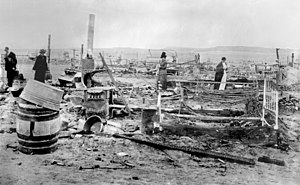
Back مذبحة لدلو Arabic Stakera ke Ludlow AVK Massakren i Ludlow Danish Ludlow-Massaker German Masacre de Ludlow Spanish Ludlow’n verilöyly Finnish Massacre de Ludlow French טבח לאדלו HE Massacro di Ludlow Italian 루드로 학살 Korean
| Ludlow Massacre | |||
|---|---|---|---|
| Part of Colorado Coalfield War | |||
 Ruins of the Ludlow Colony in the aftermath of the massacre | |||
| Date | April 20, 1914 | ||
| Location | Ludlow, Colorado, U.S. 37°20′21″N 104°35′02″W / 37.33917°N 104.58389°W | ||
| Methods | Machine guns, fire | ||
| Resulted in | Tent colony burned, Tikas and roughly 20 other residents killed. Ten days of increased fighting followed by federal military intervention. | ||
| Parties | |||
| Lead figures | |||
Louis Tikas (Organiser, UMWA) † | |||
| Casualties and losses | |||
The Ludlow Massacre was a mass killing perpetrated by anti-striker militia during the Colorado Coalfield War. Soldiers from the Colorado National Guard and private guards employed by Colorado Fuel and Iron Company (CF&I) attacked a tent colony of roughly 1,200 striking coal miners and their families in Ludlow, Colorado, on April 20, 1914. Approximately 21 people, including miners' wives and children, were killed. John D. Rockefeller Jr., a part-owner of CF&I who had recently appeared before a United States congressional hearing on the strikes, was widely blamed for having orchestrated the massacre.[6][7]
The massacre was the seminal event of the 1913–1914 Colorado Coalfield War, which began with a general United Mine Workers of America strike against poor labor conditions in CF&I's southern Colorado coal mines.[8] The strike was organized by miners working for the Rocky Mountain Fuel Company and Victor-American Fuel Company. Ludlow was the deadliest single incident during the Colorado Coalfield War and spurred a ten-day period of heightened violence throughout Colorado. In retaliation for the massacre at Ludlow, bands of armed miners attacked dozens of anti-union establishments, destroying property and engaging in several skirmishes with the Colorado National Guard along a 225-mile (362 km) front from Trinidad to Louisville.[6] From the strike's beginning in September 1913 to intervention by federal soldiers under President Woodrow Wilson's orders on April 29, 1914, an estimated 69 to 199 people were killed during the strike. Historian Thomas G. Andrews declared it the "deadliest strike in the history of the United States."[2]: 1
The Ludlow Massacre was a watershed moment in American labor relations. Socialist historian Howard Zinn described it as "the culminating act of perhaps the most violent struggle between corporate power and laboring men in American history".[9] Congress responded to public outrage by directing the House Committee on Mines and Mining to investigate the events.[10] Its report, published in 1915, was influential in promoting child labor laws and an eight-hour work day. The Ludlow townsite and the adjacent location of the tent colony, 18 miles (29 km) northwest of Trinidad, Colorado, is now a ghost town. The massacre site is owned by the United Mine Workers of America, which erected a granite monument in memory of those who died that day.[11] The Ludlow tent colony site was designated a National Historic Landmark on January 16, 2009, and dedicated on June 28, 2009.[11] Subsequent investigations immediately following the massacre and modern archeological efforts largely support some of the strikers' accounts of the event.[12]
- ^ Simmons, R. Laurie; Simmons, Thomas H.; Haecker, Charles; Siebert, Erika Martin (May 2008). National Historic Landmark Nomination: Ludlow Tent Colony (PDF). National Park Service. pp. 41, 45.
- ^ a b c Andrews, Thomas G. (2010). Killing for Coal. Cambridge, Massachusetts: Harvard University Press. ISBN 978-0674736689. OCLC 1020392525.
- ^ Walker, Mark (2003). "The Ludlow Massacre: Class, Warfare, and Historical Memory in Southern Colorado". Historical Archaeology. 37 (3). New York City: Springer: 66–80. doi:10.1007/BF03376612. JSTOR 25617081. S2CID 160942204.
- ^ McGuire, Randall (November–December 2004). "Letter from Ludlow: Colorado Coalfield Massacre: Excavators uncover chilling evidence of a brutal assault during a 1914 miners' strike". Archaeology. 57 (6). JSTOR 41780959.
- ^ Simmons, R. Laurie; Simmons, Thomas H.; Haecker, Charles; Martin Siebert, Erika (May 2008). National Historic Landmark Nomination: Ludlow Tent Colony (PDF). National Park Service. pp. 41, 45.
- ^ a b "Ludlow Massacre", Denver University
- ^ Cite error: The named reference
:2was invoked but never defined (see the help page). - ^ "The Invention of Public Relations". YouTube. Archived from the original on November 14, 2021.
- ^ Zinn, Howard (1970). The politics of history. Boston, Massachusetts: Beacon Press. p. 79. ISBN 080705450X. OCLC 67649.
- ^ United States Commission on Industrial Relations (1915). Final Report and Testimony Submitted to Congress by the Commission of Industrial Relations, The Colorado Miners' Strike. Government Printing Office. pp. 6345–8948.
- ^ a b McPhee, Mike (June 28, 2009). "Mining Strike Site in Ludlow Gets Feds' Nod". Denver Post. Denver. Archived from the original on September 26, 2018.
- ^ Simmons, R. Laurie; Simmons, Thomas H.; Haecker, Charles; Siebert, Erika Martin (May 2008). National Historic Landmark Nomination: Ludlow Tent Colony (PDF). National Park Service.
© MMXXIII Rich X Search. We shall prevail. All rights reserved. Rich X Search